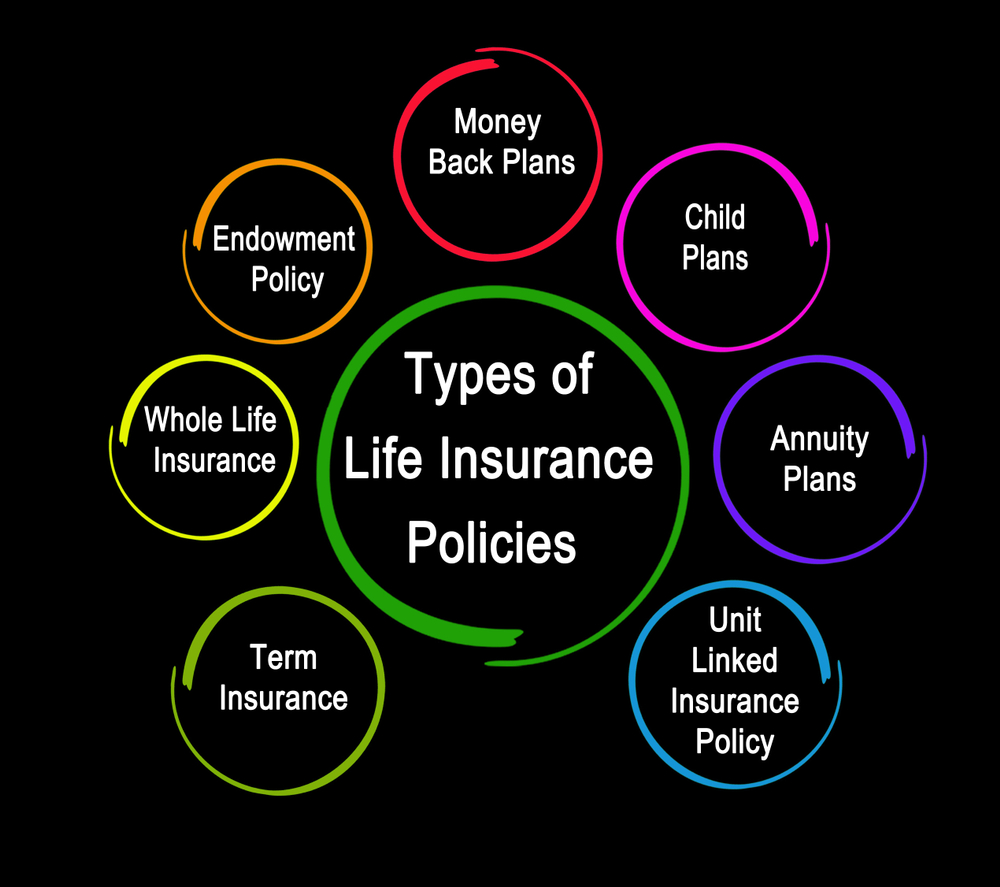Life insurance is an essential financial tool for securing one’s future. There are several types of life insurance policies available in India, each serving a different purpose. Some plans focus on providing protection to the primary earning member’s family, while others, like a ULIP policy, combine investment and insurance benefits. If you own a life insurance plan, it can help in meeting your financial goals, whether for wealth creation, retirement planning, or family protection. Let’s today explore the various types of life insurance policies.

Overview of Different Types of Life Insurance Policies in India
Type of Life Insurance |
Explanation |
Term Insurance |
Pays money to family if you pass away during the term. |
Term Insurance with ROP |
Gives back premiums if you survive the policy term. |
ULIP (Unit Linked Insurance) |
Combines life cover with investment in markets. |
Endowment Plans |
Pays lump sum at maturity, also offers protection. |
Moneyback Policy |
Give regular payouts during the policy period. |
Whole Life Insurance |
Covers you for life and builds cash value. |
Group Life Insurance |
Life cover for employees or groups. |
Child Insurance Plans |
Secures child’s future and education needs. |
Retirement / Pension Plans |
Provides regular income after retirement. |
1. Term Life Insurance Plan:
- This life insurance plan offers monetary compensation to the beneficiary only if the policyholder meets with an untimely demise during the policy period.
- If the insured survives until the policy end date, the coverage ceases.
- There may be variants, such as term plans with return of premium, where the premium amount is returned upon maturity of the policy.
- This plan does not feature any investment component or maturity benefit. Therefore, it is a relatively cheaper form of life insurance.
2. Whole life insurance plan:
- This kind of insurance plan ensures coverage for a lifetime, provided the policy is in force. Apart from providing a death benefit, a whole life insurance policy also contains a savings component.
- The cash value accumulates on a tax-advantaged basis.
- You may choose to withdraw the accrued cash value or even take a loan against it. However, in case of the insured’s unfortunate demise before the loan is repaid, the death benefits the beneficiary receives is proportionally reduced.
3. Endowment policy:
- In an endowment plan, the insurer provides a payout to the insured if he or she survives until the maturity date. Otherwise, the sum assured is paid to the beneficiary.
- This insurance option offers dual benefits of protection and savings.
- Along with providing life cover, it also helps the policyholder save regularly over time.
- A lump sum amount accumulates by the time the policy matures.
- Most insurers also offer guaranteed* additions to the invested sum or declare bonuses, increasing the returns from such policies.
- Endowment plans are also commonly known as traditional plans since these are not market-linked.
- While these serve as investment vehicles, the risk associated is far lower than most investment products.
- Although more expensive than a term plan, endowment plans can help achieve financial goals like a child’s higher education, marriage, buying property, etc.
4. Money-Back insurance plan:
- In a money-back plan, the money you invested as premiums comes back to you at regular intervals as a guaranteed income.
- You are also eligible to receive bonuses declared by the insurance company. Such policies can meet your interim needs for funds.
- Provides liquidity to policyholders at various stages.
- This is suitable for people who want money at specific intervals without having to wait for the policy to mature.
5. Retirement insurance plans:
- With these plans, you can create wealth and get a fixed income after your regular salary stops.
- This is because the premiums you pay build up a sizeable amount through the accumulation phase of such plans. After that, during the vesting period, you start getting regular payouts from the accumulated sum.
- In case of the policyholder’s unfortunate demise during the accumulation phase, the nominee receives a death benefit.
- The annuity pension plan also allows you to make provisions for your spouse to continue receiving the income after an unwanted event.
6. Unit Linked Insurance Plans (ULIPs):
- ULIP benefits are not limited to protection and wealth creation. Your premium is divided into two parts. One part goes towards securing your life cover. The other is invested in market-linked instruments.
- If you survive the ULIP policy period, you receive the prevalent market value of your investment.
- The capital market offers the possibility of generating inflation-adjusted returns through long-term investment.
- Insurers also add extra units to your investment as loyalty rewards when you remain committed to your policy for a long duration.
- A ULIP plan calculator helps you gauge the amount you need to invest in building the wealth required to fulfil your life goals.
- Also, in financial emergencies, you can withdraw a part of your accumulated units after the five-year lock-in phase.
- In case of an undesirable event, your nominee receives a lump sum amount.
7. Child plans:
- You can invest in the plan in your child’s infancy and withdraw the savings once your child reaches adulthood.
- If an unwanted event occurs during the policy period, the child plans’ death benefit takes care of your child’s financial needs.
- Most child plans also continue premium waivered until maturity, providing a pay-out to your child to meet their future monetary requirements.
- The payout can be used to finance education, marriage, or other significant life events.
- The plan includes both an insurance component and a savings component.
8. Term insurance with return of premium (TROP):
- When the policyholder survives the policy term, their premiums are returned.
- This plan combines death benefits with savings.
- Because of the return of premium features, there is a higher premium compared to regular term insurance.
- These policies appeal to individuals who desire some form of saving while also prioritising the simplicity of term insurance.
9. Group life insurance:
- Employees are provided with group health insurance by their employers or organisations.
- A group life insurance plan covers multiple people under a single policy.
- The premiums are typically lower than those for individual policies.
- Generally, it includes basic life insurance; optional add-ons may be available.
- If an insured leaves a group, their coverage might end
Tax benefits on different types of life insurance
Here are the tax advantages of different types of life insurance.
- Term life insurance: The Income Tax Act allows tax* deductions for premium payments up to Rs. 1.5 lakh per year under Section 80C. Under Section 10(10D), nominees receive a tax-free* death benefit.
- Whole life insurance: Under Section 80C, premiums can be deducted as tax* deductions, whereas the maturity benefit is tax-free*, provided the sum assured does not exceed ten times the annual premiums.
- ULIPs (Unit Linked Insurance Plans): Under Section 80C, ULIP investments qualify for tax* deductions. If annual premiums do not exceed Rs. 2.5 lakh, maturity proceeds are tax-free under Section 10(10D).
- Endowment plans: The premiums paid under Section 80C are deductible, and the maturity benefits remain tax-free under Section 10(10D) if the provided conditions are met.
- Pension plans: Section 80CCC allows deductions for premiums paid. Only one-third of the maturity amount is tax-free, and the rest must be used to pay for an annuity that is taxable.
Key factors to consider while choosing the right type of life insurance policy
There are several factors to consider when selecting a life insurance policy. When selecting a life insurance policy, keep these factors in mind:
- Financial needs and goals: Consider your financial responsibilities, such as outstanding debts, mortgage payments, education expenses, and your family's future needs. Make sure your policy aligns with your long-term financial goals.
- Analyse the policy type: It is important to understand the two types of life insurance: term life and whole life. The term life insurance provides coverage for a specific period, while the whole life insurance provides lifelong coverage as well as investment components.
- Coverage amount: Determine the life coverage that will be sufficient to secure your family's financial stability after your demise. It should factor in debts, ongoing living expenses, and future expenses, including college tuition fees.
- Affordability: Make sure premiums are affordable and fit into your budget. A term life policy is generally less costly, and a permanent policy tends to have higher premiums because it includes an investment component.
- Term length: Consider your financial obligation when you decide the duration of your policy term. For example, if your mortgage is 20 years, a policy that insures for 20 years would be suitable.
- Health and medical considerations: The cost of your premiums is influenced by your health and medical history. To avoid issues during the claims process, be transparent about your health.
- Riders and add-ons: Consider policy riders with additional benefits, such as accelerated death benefits and premium waivers. Select those that meet your specific needs.
- Policy reviews: Periodically review and adjust policies to accommodate changing circumstances or financial goals.
- Insurance provider reputation: It is important that you choose an insurance provider that is reputable, financially stable, and has a good track record of honouring claims.
- Policy conversion: Look for a term policy that can be converted to a permanent policy later without requiring a medical exam.
- Understand policy terms: Read the policy terms and conditions thoroughly, including exclusions, limitations, and conditions for payouts.
Conclusion
All types of insurance plans come with a specific benefit. With so many available options, you need to select a life insurance plan that best suits your family’s needs. For example, a term plan is essential if you are your family’s primary breadwinner. Likewise, if you are likely to have financial dependents even at an advanced age, a whole-life insurance plan may be helpful.
However, it is advisable to look into the insurer’s credibility and not settle for a policy based only on low premium rates. Tata AIA Life Insurance premiums are not only affordable, but the company has also paid 99.06% of the life insurance claims in FY20. Moreover, as of June 30, 2020, the company’s solvency ratio stood at 2.14, well above the IRDAI-prescribed minimum of 1.50. Such high figures indicate the insurer’s capability to honour its commitments towards policyholders. Thus, with a TATA AIA Life Insurance plan, you can rest assured of timely pay-outs in your hours of need.






 FOR EXISTING POLICY
FOR EXISTING POLICY 
 FOR NEW POLICY
FOR NEW POLICY 




